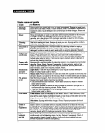
Water usage guide
Water temperature
WASH
HOT
13O’F (54°C)
or above
WARM
go”-1 10°F
(32”-44°C)
RINSE
USE FOR
COMMENTS
COLD
l Heavy soils
l Gives best cleaning for heavy
l Work clothes
soils.
l Sturdy whites and
l Removes oils, perspiration, greasy
colorfast pastels
soils and stains.
l Diapers
l Prevents graying and yellowing.
COLD
l Light and moderate soils
l Safe for most fabric finishes.
l Dark or noncolorfast
l Less fading and dye bleeding.
colors
l Reduces wrinkling.
l Moderately soiled perma-
nent press
l Nylons, polyesters,
acrylics, silks, woollens
l Knits and delicate fabrics
l Prewash, soak
COLD
70”-90°F
(21”-32°C)
COLD
l Very lightly soiled items
l Saves hot water.
l Normal soiled items if
l Less effective cleaning than hot or
extra detergent is added
warm water.
l Extra sensitive colors
l Use longest wash time in cycle
(noncolorfast)
selected.
l Rinsing, for all fabrics
l Use liquid detergent, or dissolve
powdered detergent in warm water
before adding to cold wash water.
l Pretreat spots, stains and heavy or
greasy soils.
To check your hot water temperature with a
Water hardness
candy or cooking thermometer:
1. Fill a pan with the hottest water available
from the faucet that will fill your washer.
Many poor washing results can be traced to
wash water hardness. To check your water
hardness:
2. Place a candy or cooking thermometer in
. . . .
water to cnecK tne temperature.
If you do not have a faucet at your wash site,
collect water from the faucet closest to your
washer.
l City water-ask your city water company.
Ask for the mineral content in grains-per-gallon
or parts-per-million. If your water is g or more
grains-per-gallon or more than 153 parts-per-
million:
NOTE:
In wash water temperatures colder
than 70°F (21 “C):
l Detergents do not dissolve well.
l Soils are difficult to remove.
l Some fabrics will retain wear wrinkles and
may have increased pilling.
l Consider installing a water softener.
l Use more detergent.
l Use a packaged water conditioner.
l Do not use soap.
16


















